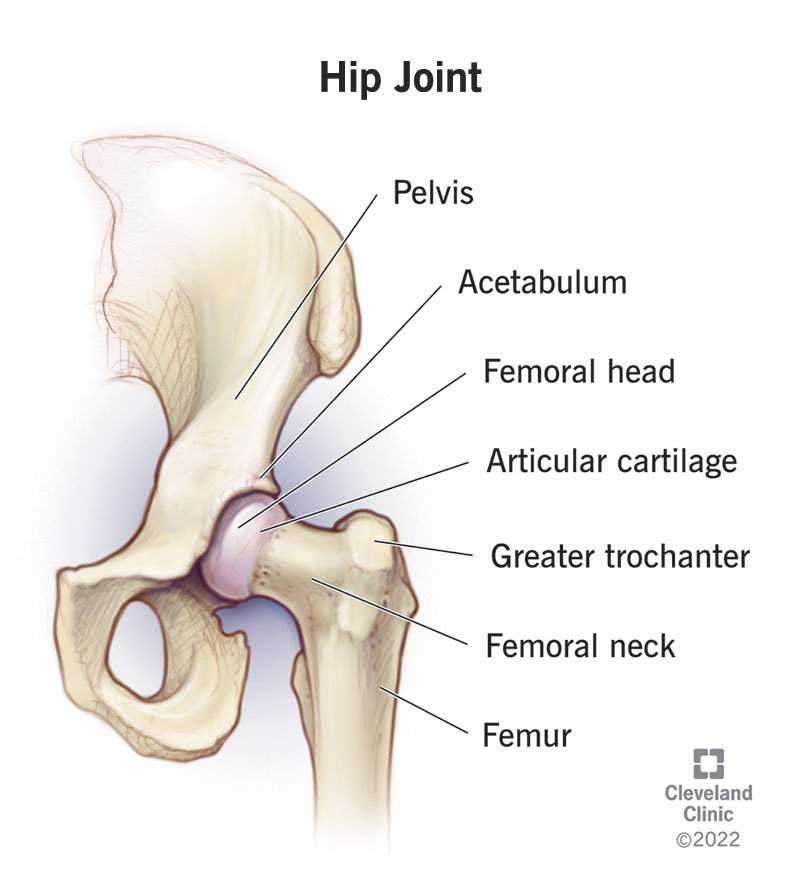Your hip joint is a connection point between your legs and your torso. Specifically, it’s made up of your thigh bone (femur) and your hip bone (pelvis). It’s a ball-and-socket joint that supports your body weight and allows you to move your upper leg.
Advertisement
Cleveland Clinic is a non-profit academic medical center. Advertising on our site helps support our mission. We do not endorse non-Cleveland Clinic products or services. Policy

A joint is a place in your body where two bones meet. Your hip joint is a connection point between your thigh bone (femur) and your hip bone (pelvis). Your hip joint is one of the largest joints in your body after your knee.
Advertisement
Cleveland Clinic is a non-profit academic medical center. Advertising on our site helps support our mission. We do not endorse non-Cleveland Clinic products or services. Policy
Your hip joint is a ball-and-socket joint. Your femur is a long bone with a rounded top. The round part of your femur fits into a cup-like socket in your pelvis called the acetabulum. This type of joint offers a wide range of motion and provides support for your legs to hold your body.
Your hip joint connects your torso (axial skeleton) to your lower legs. The function of your hip joint is to:
The ball-and-socket joint lets your upper leg move at 3 degrees so you can do the following movements:
Your hip joint is where your thigh bone meets your hip bone. You have two hip joints, one at the top of each of your thigh bones. Your thigh bones are the top part of your legs (above your knees, just below your waist, where the top of your pants sit). The part of your thigh bone that’s closest to your waist fits into your hip bone (pelvis).
Your hip joint is made up of your hip bone (pelvis) and your thigh bone (femur). Your femur is a long bone that has an angle near the top of the bone and points toward your pelvis. At the end of the thigh bone is the rounded end (femur head). This bone looks like a microphone in a stand.
Advertisement
The femur head rests inside a cup-like socket in your pelvis.
Your hip joint is one of the largest joints in your body. The top of your thigh bone (femur head) that fits into your hip bone (pelvis) is approximately 48 millimeters to 55 millimeters in diameter on the average person. This is about the same size as a small apple.
There are several components that make up your hip joint:
Your hip joints are usually very strong and stable. If you’re in good health, it could take a lot to injure your hip joints. If you play contact sports or run often, you may be more at risk of injuring your hip joint with:
There are medical conditions that can weaken your hip joint. This can put you more at risk of injury or complications like pain or stiffness. Common conditions that affect your hip joint include:
Common symptoms of hip joint conditions include:
A healthcare provider may offer imaging tests to examine your hip joint. Imaging tests like a bone density test, an X-ray or an MRI help your provider see the components of your hip joint clearly. They can detect injuries like a broken bone or a tear to your muscle or ligament.
Advertisement
Treatment varies based on what’s affecting your hip joint. A healthcare provider will diagnose and offer treatment for your hip joint that could include:
You can take care of your hip joints by:
A note from Cleveland Clinic
Your hip joint is an important part of your body. It helps you walk and move while keeping your body balanced. You can keep your hip joints healthy by exercising and stretching your muscles before you start any activities. Try not to over-exert yourself past what your body can handle. A healthcare provider will let you know how you can take care of your hip joints.
Advertisement
Last reviewed on 01/30/2023.
Learn more about the Health Library and our editorial process.